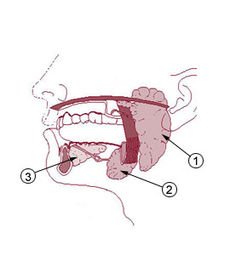Visit and Join the WeHeal Salivary Gland Cancer Community.
For more information, see: Mayo Clinic | Wikipedia

Visit and Join the WeHeal Salivary Gland Cancer Community.
For more information, see: Mayo Clinic | Wikipedia

A rare form of cancer that begins in the salivary glands. Salivary gland cancer can begin in any of the salivary glands in your mouth, neck or throat.
Salivary gland cancer is a cancer that forms in tissues of a salivary gland. The salivary glands are classified as major and minor. The major salivary glands consist of the parotid, submandibular, and sublingual glands. The minor glands include small mucus-secreting glands located throughout the palate, nasal and oral cavity. Salivary gland cancer is rare, with 2% of head and neck tumors forming in the salivary glands, the majority in the parotid.
Due to diverse nature of salivary gland neoplasms, many different terms and classification systems have been used. Perhaps the most widely used currently is that system proposed by the World Health Organization in 2004, which classifies salivary neoplasms as primary or secondary, benign or malignant, and also by tissue of origin. This system defines five broad categories of salivary gland neoplasms.
Signs and symptoms
Benign tumor of the submandibular gland, also known as pleomorphic adenoma, presented as a painless neck mass in a 40-year-old man. At the left of the image is the white tumor with its characteristic cartilaginous cut surface. To the right is the normally lobated submandibular salivary gland.
Signs include fluid draining from the ear, pain, numbness, weakness, trouble swallowing, and a lump. The most common symptom of major salivary gland cancer is a painless lump in the affected gland, sometimes accompanied by paralysis of the facial nerve.
Causes
The chief risk factor is chewing tobacco, followed by smoking. Other risk factors include older age, radiation therapy treatment to head or neck, and being exposed to certain carcinogenic substances at work.
Diagnosis
In most cases, local excision with a margin of normal tissue is the appropriate form of biopsy for a major salivary gland tumor. In the parotid region, this requires identification of the facial nerve. For submandibular tumors, the entire submandibular triangle is cleared. In contrast, minor salivary gland tumors have a higher likelihood of being malignant, and an incisional biopsy is performed initially so that definitive treatment can be planned. In the parotid region, the presence of pain, recent rapid enlargement of a preexisting nodule, skin involvement, or facial nerve paralysis suggests cancer. Enlarged cervical lymph nodes in association with a salivary gland tumor are considered a manifestation of cancer until proved otherwise. Fine-needle aspiration is indicated if accurate diagnosis will allow for better treatment planning.
Prevention
Abstaining from smoking, chewing tobacco. Maintaining a diet high in fiber and green leafy vegetables. Change your toothbrush at regular intervals (weekly)
Treatment
Treatment may include the following:
Surgery with or without radiation
Radiotherapy
Fast neutron therapy has been used successfully to treat salivary gland tumors,[5] and has shown to be significantly more effective than photons in studies treating unresectable salivary gland tumors.[6][7]*Chemotherapy.
Chemotherapy
Visit and Join the WeHeal Salivary Gland Cancer Community.
For more information, see: Mayo Clinic | Wikipedia
WeHeal is very grateful to our valued sources of information which include Wikipedia, WebMD, ClinicalTrials.gov, Cancer.gov, Infoplease, and the US CDC (Center for Disease Control).